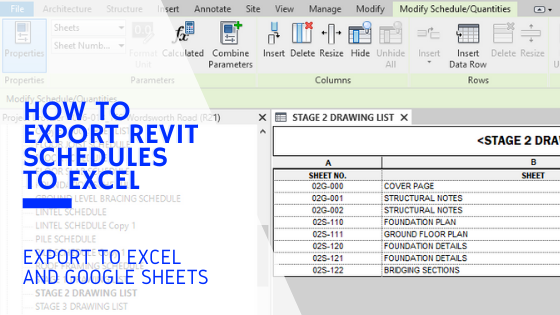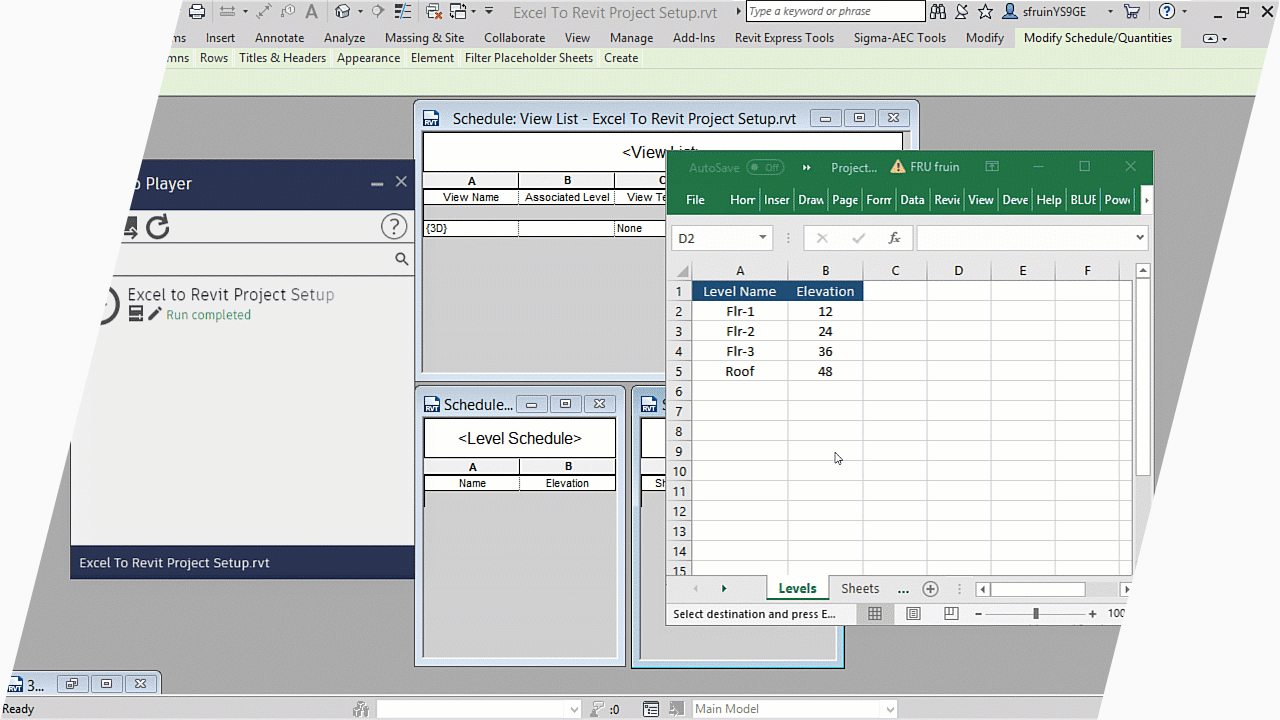Import Excel into Revit: Improving Your Process
Wiki Article
Excel-to-Revit: A Game-Changing Process for Architectural Style - Introducing the Keys
Introducing excel-to-revit, the game-changing workflow that will change your design procedure. With excel-to-revit assimilation, you can streamline your building layout, unlock effectiveness, and take full advantage of partnership within your team. Get all set to take your architectural layout to the following degree with excel-to-revit!The Power of Excel-to-Revit Assimilation

Envision the ease of being able to modify and upgrade project data in Excel, and quickly see those changes reflected in your Revit design. Say goodbye to hands-on data entrance or tiresome updates. With Excel-to-Revit integration, you can conserve time and decrease errors by leveraging the power of Excel's functions and formulas to automatically produce precise data in Revit.
Not only does this integration enhance effectiveness, but it additionally improves cooperation among employee. You can quickly share Excel data with coworkers, who can then import the information into their Revit versions. This promotes a smooth exchange of information and ensures that everyone is collaborating with one of the most updated data.

Streamlining Building Layout With Excel-To-Revit
Enhancing building layout is made simpler with making use of Excel-to-Revit (revit tool). With this powerful combination, you can maximize your operations and conserve important time throughout the design procedure. By leveraging the abilities of Excel and Revit, you can effortlessly move data in between both systems, eliminating the requirement for hands-on data entrance and decreasing the danger of errorsExcel-to-Revit allows you to import and export data easily, allowing you to quickly update and customize your building styles. You can create schedules, compute quantities, and create reports in Excel, and after that move that information straight right into your Revit model. This integration ensures that your layout information is always updated and synchronized, eliminating the requirement for hand-operated updates and reducing the opportunities of variances.
By making use of Excel-to-Revit, you can additionally take benefit of the effective computational capacities of Excel. You can carry out intricate calculations, analyze data, and automate repetitive tasks, all within Excel. Then, with simply a couple of clicks, you can import the results back into Revit, permitting you to make educated design decisions and optimize your architectural styles.
Unlocking Performance: Exploring the Excel-to-Revit Operations
Maximize your efficiency by seamlessly integrating Excel and Revit for a much more reliable operations. With the Excel-to-Revit operations, you can open an entire new level of effectiveness in your building style process. By utilizing the power of Excel's data management abilities and combining it with the versatility and accuracy of Revit, you can improve your layout process and conserve valuable time.Among the vital advantages of this combination is the ability to import and export data in between Excel and Revit. This suggests that you can quickly transfer task information, such as area timetables or material amounts, from one software application to the various other, eliminating the requirement for hand-operated information entry and minimizing the chances of errors. You can also produce custom solutions and estimations in Excel to automate repetitive jobs and carry out complex calculations, which can after that be seamlessly incorporated right into your Revit versions.
Additionally, the Excel-to-Revit operations permits better sychronisation and partnership between employee. With Excel working as a central data center, multiple group participants can deal with different facets of the job simultaneously, sharing and updating info in real-time. This not only boosts communication but also makes sure that every person is dealing with one of the most up-to-date data, eliminating the threat of incongruities.
Making The Most Of Cooperation: Excel-to-Revit for Architectural Teams
By seamlessly incorporating Excel important site and Revit, building groups can substantially boost partnership and attain a lot more efficient design outcomes. When utilizing this powerful operations, you can easily move data between Excel spreadsheets and Revit models, improving the style procedure and boosting interaction among team members.In addition, by leveraging Excel's powerful estimation capabilities, you can perform complicated computations and evaluation on your design information, offering useful insights and driving notified decision-making. This integration also enables you to export information from Revit to Excel, allowing you to produce comprehensive reports, charts, and charts for presentations and analysis. This joint operations advertises efficient interaction and control amongst employee, as Excel functions as a main center for data monitoring and sharing.
Overall, by embracing the Excel-to-Revit workflow, building teams can attain greater levels of cooperation, performance, and accuracy in their layout procedure. revit tools. This integration equips groups to collaborate seamlessly, making sure that everybody gets on the same page and contributing to the success of the project
Revealing the Tricks of Excel-to-Revit Assimilation

One of the keys of Excel-to-Revit assimilation is the capability to utilize the power of formulas and estimations in Excel to drive criteria and create facility geometries in Revit. You can link Excel spreadsheets to Revit households, enabling you to input information directly right into the spread sheet and have it immediately update in the Revit version. This simplifies the layout process and makes certain precision and consistency throughout the project.
resource An additional secret is the ability to create custom-made routines and records in Excel, utilizing data removed from Revit. This permits you to assess and imagine task information in a manner that is not possible within Revit alone. You can quickly generate amount liftoffs, expense price quotes, and task timelines, offering valuable understandings for decision-making and job monitoring.
On top of that, Excel-to-Revit integration allows efficient cooperation among employee. Numerous individuals can work with the very same Excel spread sheet simultaneously, making it simpler to coordinate and track adjustments. You can also make use of Excel's commenting function to give feedback or interact style revisions.
Verdict
By incorporating the power of Excel and Revit, designers can now work a lot more successfully, conserve time, and produce far better designs. Start incorporating excel-to-revit assimilation right into your architectural layout process today and revolutionize the means you function.With simply a few clicks, you can import the results back right into Revit, permitting you to make educated style decisions and enhance your building layouts.
By using the power of Excel's data administration capacities and combining it with the versatility and precision of Revit, you can streamline your style procedure and conserve valuable time.
By flawlessly incorporating Excel and Revit, architectural groups can significantly boost cooperation and achieve a lot more effective design results. When using this powerful process, you can easily transfer information between Excel spread sheets and Revit versions, streamlining the design procedure and improving communication amongst team members.Moreover, by leveraging Excel's effective estimation capabilities, you can execute intricate estimations and analysis on your design information, providing important insights and driving my blog notified decision-making.
Report this wiki page